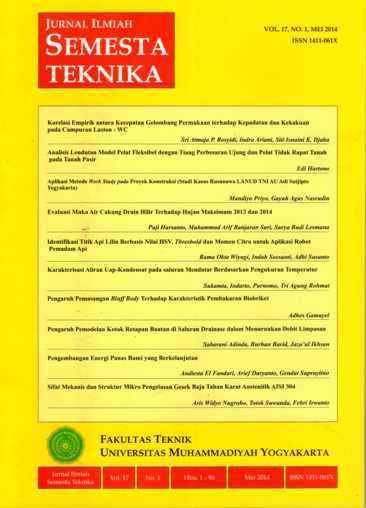Karakterisasi Aliran Uap-Kondensat pada Saluran Mendatar Berdasarkan Pengukuran Temperatur
DOI:
https://doi.org/10.18196/st.v17i1.408Abstract
The objective of the current investigation is to find out temperature distribution regimes in a horizontal pipe when condensation process is happened. The research was conducted at Pusat Studi Ilmu Teknik Universitas Gadjah Mada. The experiment apparatus consists of an inner annulus pipe made from copper (din = 17.2 mm, do = 19 mm) with the length of 1.8 m. The outer annulus pipe is a galvanized iron pipe (din = 108.3 mm, do = 114.3 mm) with the length of 1.6 m. Thermocouples type K 36 TT OMEGA with chromel (+) and alumel (-) materials were used as temperature sensors, to detect the spread of temperature in radial or axial direction along the pipe. The measurement ranged from -50 to 260 oC, with an accuracy of 0.01 °C. A data logger of RX 40 serial (OMRON, 20 Channels) was used to read and record temperature data with the sampling rate of 5 Hz. In the experiment, the water (H2O)was heated using a boiler to generate steam which was then flowed and condensed inside the annulus pipe to form a steam-condensate two-phase flow in horizontal pipe. On the other hand, the water was used as a coolant in the outer of annulus pipe. The results indicated that the temperature distribution regimes are influenced by axial posisition.The farther distances from the inlet the lower the temperatures being recorded which indicate the increase of film condensate thickness. Such phenomena can affect slugging in the location.
Downloads
Published
How to Cite
Issue
Section
License
Semesta Teknika is licensed under a Creative Commons Attribution 4.0 International License.
Authors who publish with this journal agree to the following terms:
- Authors retain copyright and grant the journal right of first publication with the work simultaneously licensed under a Creative Commons Attribution License that allows others to share the work with an acknowledgement of the work's authorship and initial publication in this journal.
- Authors are able to enter into separate, additional contractual arrangements for the non-exclusive distribution of the journal's published version of the work (e.g., post it to an institutional repository or publish it in a book), with an acknowledgement of its initial publication in this journal.
- Authors are permitted and encouraged to post their work online (e.g., in institutional repositories or on their website) prior to and during the submission process, as it can lead to productive exchanges, as well as earlier and greater citation of published work (See The Effect of Open Access).









